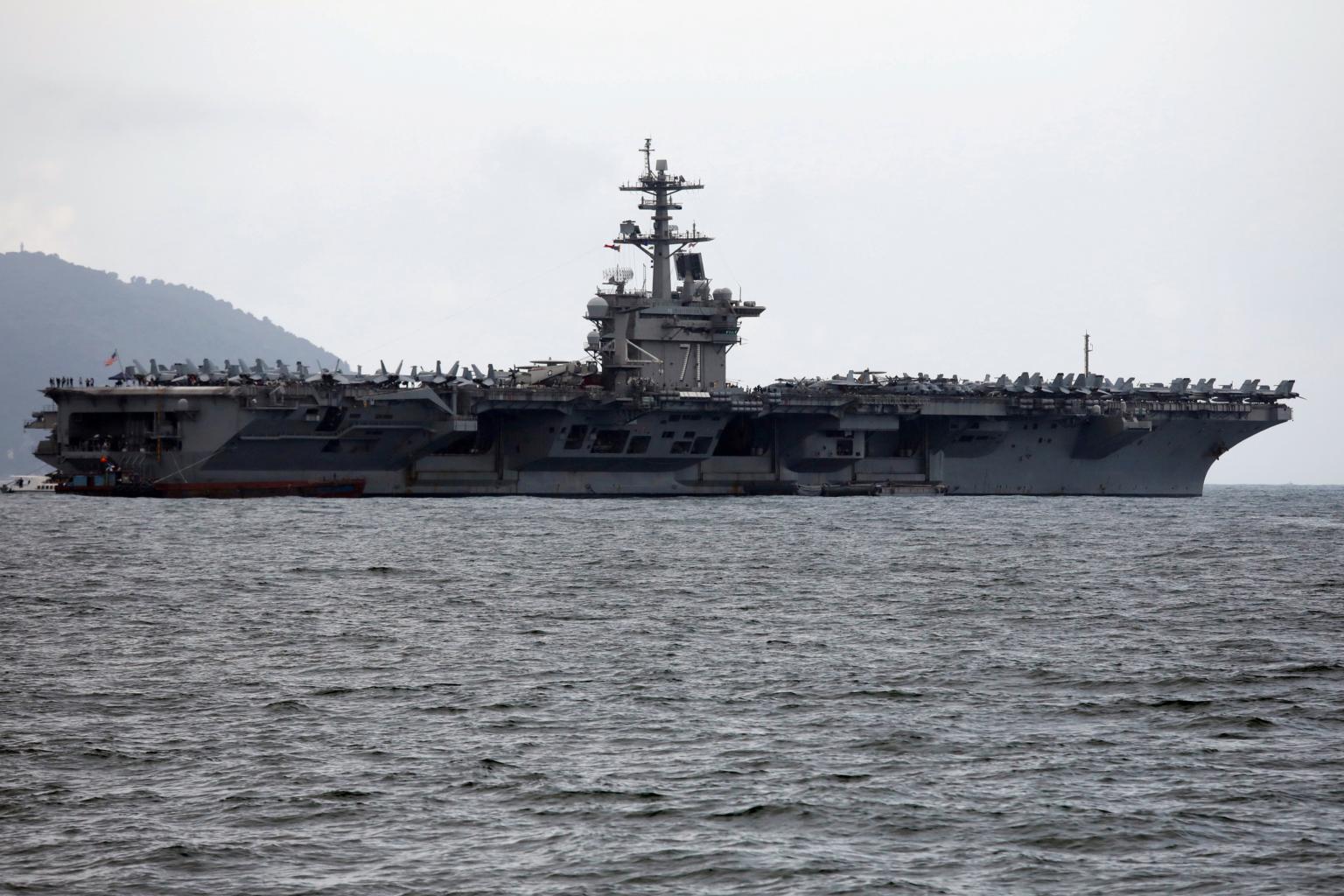In Guam, the aircraft carrier Roosevelt is still battling coronavirus
Sign up now: Get ST's newsletters delivered to your inbox

In a photo taken on March 5, 2020, the USS Theodore Roosevelt (CVN-71) enters into the port in Da Nang, Vietnam.
PHOTO: REUTERS
Follow topic:
WASHINGTON (NYTIMES) - The aircraft carrier USS Theodore Roosevelt continued its monthslong fight against the novel coronavirus, with at least one sailor aboard the ship testing positive, according to crew members.
The infected sailor, who had tested negative before reboarding the Roosevelt, was quickly whisked off the ship, which is docked in Guam as Navy officials make preparations for the vessel to deploy.
The episode underscores the stubborn challenges facing top Navy officials as a second investigation into the service's handling of the virus - this one by the Defence Department's inspector general - got underway this week.
Navy officials said they had been aggressively screening and testing as crew members return to the Roosevelt after quarantining in Guam over the past month. Officials on the ship, they say, are requiring masks and repeatedly cleaning and sanitising to prevent another outbreak of the virus that struck in March, which infected about 1,100 crew members.
The crew's attempts to stop the virus from returning have turned into a frantic game of cat and mouse. Sailors in what looked like biohazard suits were assigned to clean one area of the ship this week, while two hangar bays were unexpectedly sealed off Tuesday (May 12) right before food was served pier-side to transfer to shore a sailor, most likely infected with the virus, according to those on board.
In one email sent to much of the crew Tuesday, a sailor in the medical department said that a current crew member who was undergoing medical screening had failed for four days to report an inability to smell, often a symptom of the virus.
"Please stress the importance of being truthful," the email read. "So we don't potentially have Covid+ aboard this ship."
These daily setbacks, along with the Navy's timetable to get the ship back to sea, have left the vessel's commanders with difficult choices. One idea under consideration is to stop the remaining sailors quarantined on Guam from returning to the ship and setting sail with a smaller crew.
In a message to the crew Wednesday night, broadcast over the Roosevelt's main loudspeaker system, the commander of the ship, Captain Carlos Sardiello, said that medical scrutiny aboard had increased, comparing the ship to a rose garden still riddled with weeds. And he emphasised that the ship's departure date was based on the conditions on board.
Capt Sardiello's remarks may conflict with the Navy's desire to push the Roosevelt back to sea as soon as possible, with the hopes of uniting his carrier with two others - the USS Ronald Reagan and the USS Nimitz - for a public show of strength in the Pacific Ocean.
Navy officials said Wednesday that anyone aboard the Roosevelt who displayed symptoms associated with the coronavirus was immediately tested and, regardless of the results, taken off the ship. The Navy has stopped releasing daily updates on the number of virus cases among the crew after publicly announcing that all sailors had been tested.
The Navy's top leaders are eager to put the Roosevelt's problems behind them and to project an image that the fleet is ready to confront threats around the globe.
But aboard the Roosevelt, the ship's continued infections have quickly become the theme of the deployment.
A "cruise" patch, designed by one of the aircraft squadrons on board, resembles the Corona Beer logo - except in this case it reads, "Corona Virus Cruise, USS Theodore Roosevelt, WestPac2020." In the centre are the words "Double Dragon for You," a subtle nod to the Navy's nickname for a stomach virus often transmitted while at sea.
Admiral Michael Gilday, the chief of naval operations, wrote on Twitter over the weekend heralding news that six of the Navy's 11 carriers were now at sea. In fact, only two of the nuclear-powered carriers, the USS Harry S. Truman off the East Coast and the USS Dwight D. Eisenhower in the Persian Gulf region, are on monthslong deployments. The other four ships are conducting training or qualifying crew members.
And the Roosevelt's return to the Pacific has been delayed by other factors related to the virus. The series of events prompted by the virus' arrival on the Roosevelt caused a political uproar in Washington and led to the removal of the ship's captain and the resignation of the acting Navy secretary.
The new positive case on the Roosevelt comes as a second investigation of the Navy's handling of the virus - this one by the Defence Department's inspector-general - was announced this week.
The inspector-general said in a statement that it would assess the effectiveness of policies and procedures the Navy has put in place to prevent and mitigate the spread of infectious diseases, including the coronavirus, on surface warships and submarines. A spokeswoman declined to say when the report would be completed, but such reviews typically take at least several weeks.
Meantime, a wider Navy inquiry into the events aboard the Roosevelt continues. That investigation, led by Adm. Robert Burke, the vice chief of naval operations, was directed last month by the acting secretary of the Navy, Mr James McPherson.

